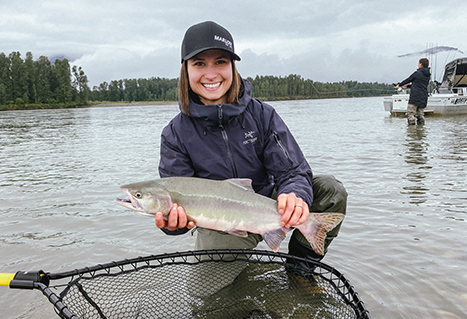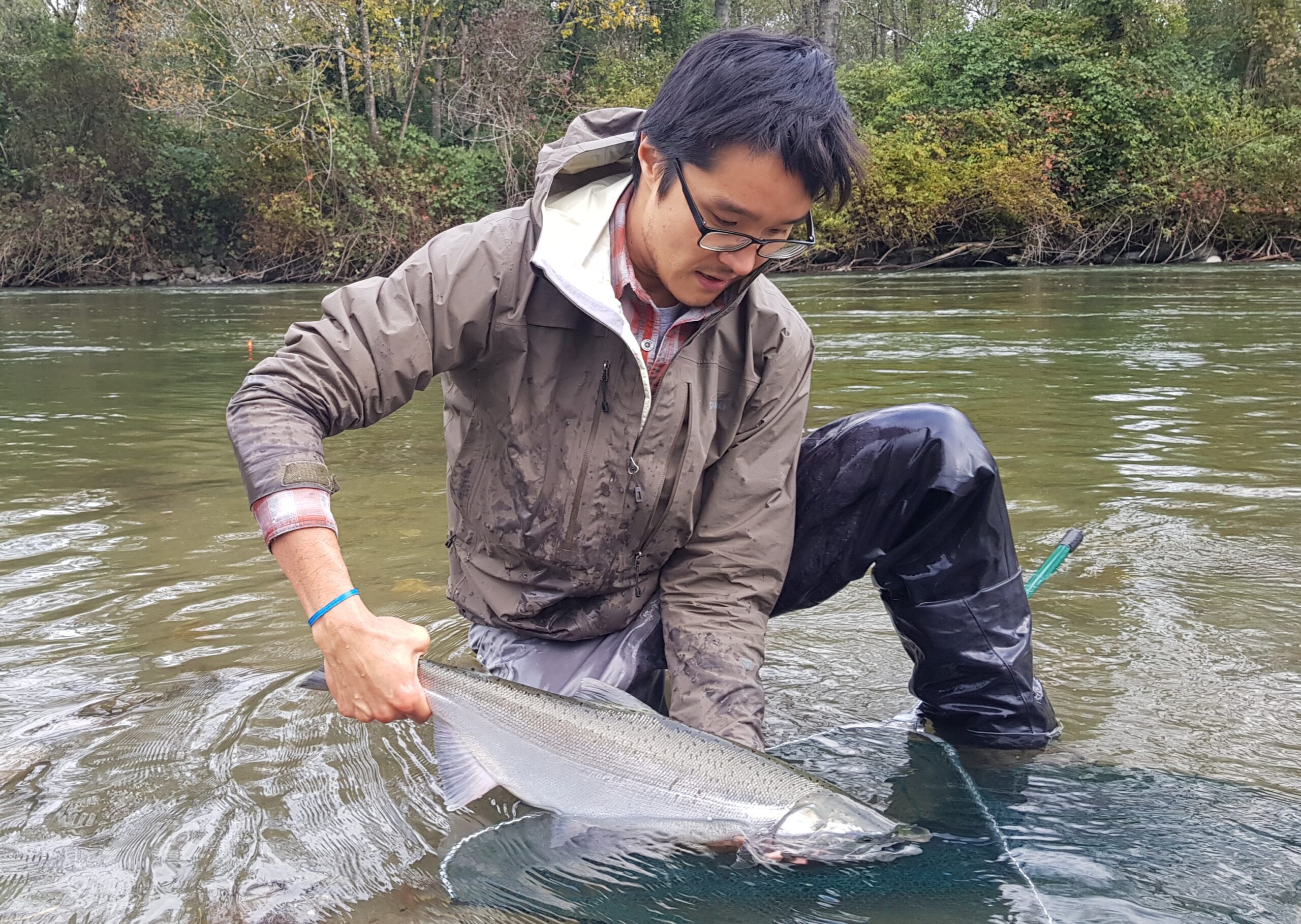The arrival of fall coincides with some great freshwater fishing for Pacific salmon. Generally, coho begin entering many rivers along the West Coast in early September, followed later in the month by chinook and chum. Coho are known for their acrobatic fights when hooked, and for their great taste. Chinook can reach massive sizes, with catches over 15 kilograms not uncommon, while “pound-for-pound,” chum are considered the hardest-fighting of the five salmon species.


Fishing Techniques for Salmon in Freshwater
Float-Fishing for Salmon in Freshwater
On medium- to fast-flowing rivers, float fishing – fishing lures or baits suspended below a fishing float – is one of the most productive methods for catching fall salmon. This technique is also known as “short floating.” A typical set-up for float fishing uses a 3.0- to 3.65-metre (10- to 12-foot) medium-action rod matched to a levelwind or centrepin reel (such as the Rapala Delta Series Levelwind or Classic Drifter Centrepin Reel), loaded with 5.44- to 6.80-kilogram (12- to 15-pound) test monofilament main line.
In very clear water, or when fishing soft-flowing, shallow water, use fishing floats as small as 15 grams. In heavier-flowing, deeper water, use a fishing float up to 30 grams. Add enough pencil lead or sliding weights to the mainline above a barrel swivel so that only the top centimetre (½-inch) of the float sits above water. Below the swivel, tie on your bait hook or lure using a short 45-centimetre (18-inch) fluorocarbon leader in the 3.6- to 5.44-kilogram (eight- to 12-pound) test range. A short leader helps to keep your bait down in the zone where the fish can see it. Fluorocarbon line is thinner in diameter than monofilament, and virtually invisible to fish underwater, which allows you to use slightly heavier leaders to prevent disappointing break-offs with big fish.


Cured roe (from chinook, coho, or chum salmon) is one of the most productive baits, but be sure to check your local regulations – the use of roe and other natural baits is prohibited on some rivers, including all streams on Vancouver Island. You can purchase cured roe in some tackle stores, or cure your own if you harvest a female salmon. There are many pre-packaged brine mixtures on the market that will produce quality cured roe in various colours. Store the cured roe in powdered Borax, either in your fridge or freezer. Artificial lures like Colorado-blade spinners, wool/yarn ties, and jigs can also be effective.
Adjust the distance between your float and weight so that you’re fishing well off the bottom: 30 to 60 centimetres (one to two feet). A common mistake among new anglers is fishing too close to the bottom, which makes it virtually impossible to detect subtle takes, and risks snagging the bottom or even foul-hooking fish.
If possible, position yourself slightly up-river from where you expect the fish to be holding. By casting straight out, or slightly upstream, you will avoid having your float and lure land directly on top of the fish and spooking them. This will also give your bait time to sink to the strike zone. With your reel in free-spool, let the current carry your float downstream. Hold back your main line ever so slightly to allow your bait or lure to run ahead of the float and weight, while still achieving a drag-free drift. Chinook will typically bury your float; coho takes are much more subtle. When short floating, you can be confident that this really is a fish striking, and not the bottom. Set the hook quickly enough, and you’ll be rewarded.
Spincasting for Salmon
Fishing slow-moving backwaters for coho can be an exciting way to explore new water and get away from the crowds. These fish are best targeted spincasting and retrieving medium-sized spinners or spoons (or even a cast and retrieved fly). No float or added weight is required for this type of fishing. My go-to coho lures are ¼- to ¾-ounce Luhr Jensen Krocodile spoons in hammered chrome, chrome with a blue or green stripe, and hammered brass with an orange stripe, as well as well as #3 (¼-ounce) Blue Fox spinners in silver, silver with orange, silver with chartreuse, and copper.

Jigs. | Nick Basok.

Fly-Fishing for Salmon
Fly-fishing is also extremely effective in these slow or still water situations. You will want at least a six-weight fly rod (heavier if you anticipate hooking chum) matched with an intermediate sinking line, and a long leader. Small flies are usually the ticket. One of the most productive coho flies is an olive crystal flash Woolly Bugger, tied with a weighted gold bead head on a size 8 nymph hook.


Bar Fishing for Salmon
Bar fishing is another popular method, used on the main flows of large river systems. It consists of tying your main line to the swivel end of a commercially available bar fishing spreader rig, then clipping a 340- to 680-gram (12- to 24-ounce) wedge weight (heavy enough that the gear holds onto the bottom in the current) to the rig’s other end. You will need a medium-heavy or heavy action rod to cast these big weights out, and a reel loaded with 29- to 37-kilogram (65- to 80-pound) test braided superline. Using a short 18- to 27- kilogram (40-to 60-pound) test leader, tie a Worden’s Spin-n-Glo lure (in sizes #2 and #0) with a large 4/0 to 7/0 barbless hook to the rig’s spreader extension. Cast the bar rig into the river, and place the rod in a rod holder. No float is used with this set-up; instead, watch your rod tip for signs of a strike. Bar anglers will often place a bell on their rod to help detect strikes. This can be a very relaxing, family-friendly way to fish.


Where and When to Fish for Salmon
You can have success fishing for salmon any time of day, particularly in remote areas, where the fish tend to receive less angling pressure and are typically less wary. However, on river systems with a lot of angling pressure, fish during low-light conditions – either from first light until shortly after sunrise, or dusk until last light. Bigger, more aggressive chinook and chum are generally found in larger, deeper runs and pools, driving the smaller coho into long tailouts, smaller riffles, and backwaters.
Knowing When to Go: River Flow Rate
The stream discharge (or height) or flow rate can change dramatically on a daily and even hourly basis, which can play a huge role in the success or failure of your salmon fishing trip. The Government of Canada’s hydrometric monitoring system provides flow rate information for many streams in B.C. This website can tell you whether your favourite stream is rising or falling, or perhaps even completely “blown out.” The rule of thumb is that streams fish better when they are dropping and clearing.
Licensing Requirements for Salmon Fishing
Please remember, single barbless hooks must be used in all streams in B.C. If you are targeting salmon in freshwater and plan to retain your catch, you require a Non-Tidal Salmon Conservation Surcharge Stamp in addition to your basic Freshwater Fishing Licence. Freshwater salmon fishing regulations vary from river to river and from year to year – be sure to check the in-season openings/closures and other restrictions prior to heading out on the water.
Additional Resources
Author: Mike Gass, Freshwater Fisheries Society of BC
Banner Photo: Rodney Hsu.
